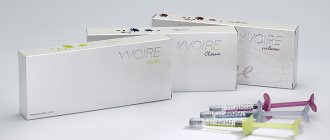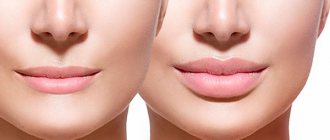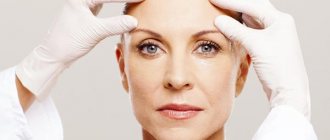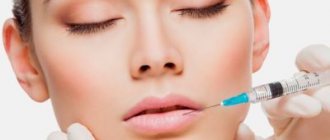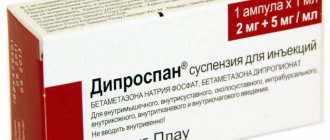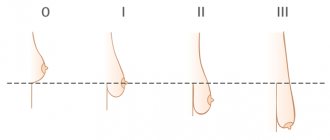Today, contour plastic surgery is one of the most popular methods for quickly and effectively eliminating such aesthetic imperfections as aging and loss of skin elasticity. This rejuvenation effect is achieved by introducing special absorbable gels – fillers – into the dermis. So what are fillers, and how does hyaluronic acid work in them?
All contouring preparations contain stabilized hyaluronic acid of non-animal origin (Non-Animal Stabilized Hyaluronic Acid (NASHA). Non-animal HA is obtained by biotechnological means, so there is absolutely no risk of an allergic reaction, no preliminary testing is required.
In more outdated preparations, non-absorbable materials (biopolymer gel) and HA of animal origin were first used. At the moment, both the biopolymer and HA of animal origin are recognized as dangerous to humans and are prohibited for use in the Russian Federation due to their non-biocompatibility. The concept of “biocompatibility” is defined as “the ability of a material to achieve the appropriate response in the body in each application.” HA itself is completely biocompatible. The biocompatibility of NASHA has been extensively studied in vitro and in vivo. Testing was carried out in accordance with ISO (International Organization for Standardization) standard 10993 for “Biological evaluation of procedures used in medicine.”
Biocompatibility tests have demonstrated that hyaluronic acid:
- does not have cytotoxicity or genotoxicity;
- does not cause acute, subacute or chronic effects;
- does not cause hypersensitivity reactions.
Officially, Roszdravnadzor allows the distribution and use of only dermal implants (as fillers are officially called), which contain exclusively synthesized hyaluronic acid, or HA of non-animal origin. Such drugs include Genyal fillers.
How does GC work?
Stabilized Hyaluronic Acid molecules are capable of holding huge amounts of water. This unique ability of HA allows you to preserve the effect of the contour modeling procedure for a long time. Hyaluronic Acid (HA) is a substance that is not only a component of the tissues of all organisms, but is also identical in structure in all living beings. HA plays an important role in the body by binding and retaining water in the skin, creating volume in the eyeball, maintaining the elasticity of joints, ligaments, etc.
Stabilized Hyaluronic Acid in its pure form is very quickly destroyed by the body's enzyme system. To slow down the process of biodegradation and retain HA in tissues, manufacturers of contouring products conduct thousands of scientific studies and develop more and more stable forms of the acid molecule. In earlier fillers (first generation fillers), HA was stabilized by special chemical impurities, which over time caused allergic reactions. Gradually, manufacturers found a safer way for the patient to stabilize HA - with the help of glycerol, which is also found in our body and therefore is not a potential allergen.
In Genyal preparations, which are the third generation of fillers, hyaluronic acid is stabilized by glycerol, which eliminates the risk of allergic reactions or filler rejection.
Algeness® gels: subtleties of contouring with agarose-based fillers
Algeness® fillers are the result of 10 years of rigorous scientific research and clinical testing. Their goal was to find the most optimal solution for contouring - a material with the highest biocompatibility, which would advantageously compensate for the volume lost with age and fill even the deepest wrinkles.
Read the latest articles on Telegram!
Algeness® agarose fillers, presented by , are stable hydrocolloid gels that contain 1% agarose and 99% saline. Thanks to this, in the tissues they acquire any necessary shape, resulting in the most natural result.
Extensive research was required to understand how different agarose structures interact with body tissues. Because its various three-dimensional structures had completely different characteristics.
How do fillers work?
The elastic particles of gels in preparations for contouring can be compared to building blocks. When injected, the “blocks” form a supporting frame in the area of folds and wrinkles, smoothing out skin defects and creating a surface lifting effect. In this way, you can remove both fine and deep wrinkles and creases, giving the skin a more youthful and radiant appearance. In addition to the tissue “filling” effect, HA is capable of attracting large amounts of moisture, which promotes enhanced skin hydration.
Indications for the contour plastic procedure:
- correction of facial contour deformities
- changing the shape and increasing the size of lips, cheekbones, cheeks, chin
- face oval correction
Optimal results in correcting age-related changes are achieved if the defect can be completely leveled by stretching it with your fingers. The degree of correction and duration of the effect of the procedure are strictly individual and depend on the structure of the skin defect, the volume of injected material, the technique of inserting the implant, as well as the age, facial activity and lifestyle of the patient. Practice shows that in most patients after 6 months the effect remains 50-80%.
Genyal brand fillers are very flexible and easy to use, and the correction effect lasts from 8 to 18 months.
What is special about Algeness® filler?
Uma Thurman's tea rinse. Uma's hair is naturally very thin, and prone to oiliness, which means it quickly loses its well-groomed appearance. To solve the problem, the actress came up with her own way. She admitted that after washing, she rinses her hair with strong tea and then rubs lime juice into her roots. However, says the Hollywood diva, the procedure can be done without washing your hair. Greasy strands just need to be dried with a hairdryer, and then they will look clean.
Newly developed, Algeness® is a biomaterial consisting of a purified agarose gel (polysaccharide) obtained through a complex, proprietary manufacturing process. This is his innovation. By its nature, agarose gel is an extract from brown algae and its molecular properties are similar to hyaluronic acid. This is a polysaccharide. But the peculiarity of agarose gel is that its structure in tissues becomes hydrocolloid. That is, it forms a stable hydrogel that creates volume but does not attract water. Another feature of the drug is that it is 100% natural and does not contain harmful chemicals, solvents or cross-linked agents, so it is safer than other fillers.
Techniques for introducing fillers into various areas of the face
Depending on the area targeted for correction, contouring preparations are injected into different layers of the skin. During the procedure, the doctor uses various techniques for administering drugs.
1. Techniques for correcting nasolabial folds and wrinkles on the bridge of the nose:
- Linear injection technique: a continuous line of gel is formed along the entire length of the wrinkle/fold, lifting the skin at the injection site to the desired level.
- Point injection technique: injections are placed pointwise along the line of the wrinkle/fold being corrected, merging into a single soft continuous line.
2. To create additional volume of tissue, as well as for deep folds, the “Fan” and “Lattice” injection techniques are used. These techniques, with minimal trauma to the skin, allow you to create an even supporting frame inside the dermis.
What do you need to know before undergoing Algeness® filler treatment?
Is Algeness® right for you?
Fillers are 100% natural, so they are suitable for those who want to restore youth, fill wrinkles and correct the contours, shape and volume of the face.
Is the procedure painful?
“Not a day goes by that I don’t take my vitamins. I approach the choice of dietary supplements seriously - using the results of blood tests, together with the doctor, I identify what my body lacks. “As a rule, I am prescribed a lot of fish oil.” Gwyneth Paltrow, actress
All injections cause an unpleasant feeling and pain. However, the doctor may decide to apply local anesthesia (such as numbing cream) to the injection area. The injection area will become numb. The procedures are relatively painless, although there may be some discomfort during the session and the client may feel pressure from the needle.
What are the side effects?
There may be slight discomfort during the procedure. Once completed, there may be some redness around the injection site and some swelling, which may last 1 to 2 days.
Post-procedure care
After the procedures, you should not touch your face with your hands or any cosmetic devices (sponges, brushes, etc.) to avoid infection through punctures. You can apply makeup one day after the procedure. It is recommended to apply sunscreen for 5-10 days after injections to prevent hyperpigmentation.
For three days, it is not recommended to engage in sports or swimming, or expose your face and body to hot temperatures (baths, saunas, solariums).
The result of correction with polylactic acid gel
After the procedure, the visible effect occurs almost immediately. Over time, visual signs of rejuvenation become more pronounced. Thanks to the effect of PLA microgranules, anti-aging changes occur in all layers of the skin at the cellular level.
As a result, the client notes:
- lasting effect of real rejuvenation at any age;
- compensation for lost volume in the area of the temples, cheeks, cheekbones;
- reconstruction of dense facial contours, chin area, clear cheekbone line;
- smoothing out facial wrinkles in areas around the eyes and mouth covered with thin, delicate skin;
- visible changes in the density and color of the skin of the face, neck, décolleté, and hands;
- elimination of facial wrinkles, age spots, post-acne marks;
- narrowing of pores, smoothness, elasticity, healthy complexion.
About complications
Unfortunately, there is currently an increase in complications of ICP, which is associated with various factors, including the expansion of indications, in particular with the introduction of fillers into the deep layers of tissue (subcutaneous, axillary).
Experts often make mistakes due to lack of experience and knowledge of the topographic and anatomical features of the face. Another equally common cause of adverse events that occur after the injection of fillers is the individual sensitivity of the patient either to a certain material or to the introduction of a foreign body in general.
Both the increase in allergization of the population as a whole and medical errors - such as unreasonable combinations of various rejuvenation agents (mesothreads, biorevitalizants, etc.) or the use of fillers of various natures in one area of the face - inevitably lead to an increase in complications, in particular reactions of immediate or delayed skin sensitivity . For example, the development of chronic aseptic skin inflammation associated with an allergy to filler components can cause tissue ischemia, infection and necrosis, which requires urgent surgical treatment, massive antibiotic therapy, and the introduction of hyaluronidase.
The most typical undesirable side effects of ICP are swelling of facial tissues and an unnatural appearance due to overcorrection with stabilized HA fillers. The development of edema is most often caused by impaired vascular drainage due to tissue ischemia when an excess volume of filler is introduced, or by the peculiarity of the tissue response in a particular area of the face. In this case, enzymes should be used - hyaluronidase, longidase, lidase, which cause resorption of HA. To quickly eliminate the problem, the best option is injections of these enzymes. At the same time, the application of external preparations with enzymes and/or phonophoresis allows for more delicate control of the resorption process.
Infectious complications (abscesses or bacterial films) have become increasingly common, especially when performing deep injections or working with a cannula. Often their reason is trivial - the treatment room does not meet the requirements for a room for performing ICP, or the medical staff does not comply with the rules of asepsis.
Fillers from the Ellanse line
This sterile, completely self-absorbing dermal implant, developed and manufactured by AQTIS Medical BV (Netherlands), is a biostimulator and, unlike other dermal fillers, has stable effectiveness, a unique predicted duration of action from 1 year (Ellanse-S) to 4 years ( Ellanse-E) and complete and predictable biodegradation (STaT technology). Ellanse consists of perfectly smooth spherical polycaprolactone (PCL) microspheres (25-50 µm-30%), without cross-links, uniformly suspended in a special water-based carboxymethylcellulose (CMC) gel carrier (70%).
It should be noted that polycaprolactone has been widely used in medical practice for 40 years, its use is approved by the US Food and Drug Administration (FDA). In particular, it is well known as a biodegradable (breaks down and is completely eliminated from the body) soft medical suture material. Biocompatibility, complete absorption, elasticity of this polymer, absence of side effects - these are the qualities that became the key reason for the creation of a dermal filler based on it. This is certainly an alternative to hyaluronic acid with a high safety record.
